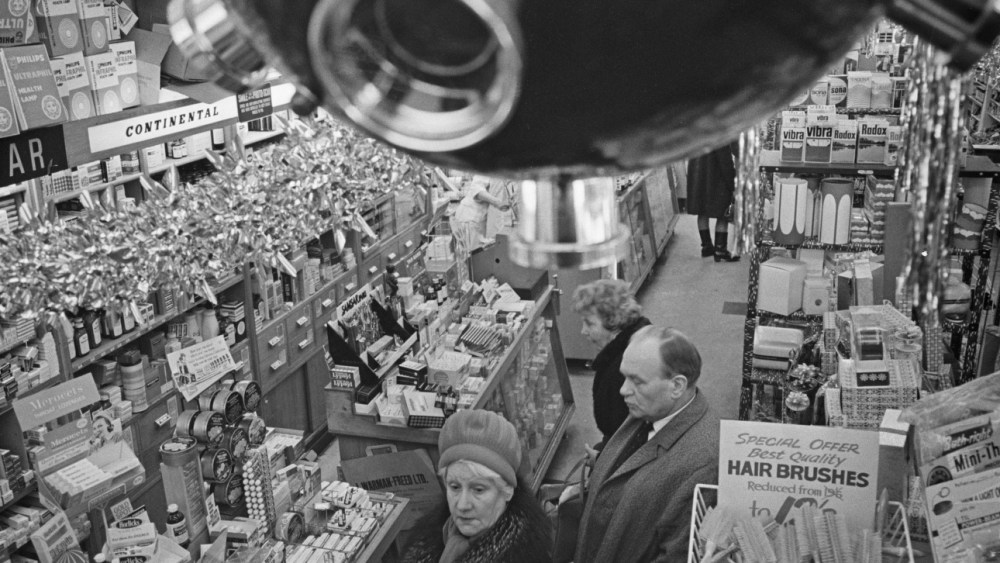The retail environment is an open one.
Shoppers come into stores to browse, touch products, try on fashions, read the fine print on skin creams and, if they connect, buy something and leave with the goods. But that openness has been working against merchants in this post-pandemic world as more people come to pick up product, but leave without paying.
The adolescent five-finger discount and more concerted shoplifting efforts by groups of thieves — what is now called organized retail crime — have always been a part of the industry. But now it’s something more.
During the pandemic, mass merchants and drug stores began putting more of their product under lock and key warding off garden variety shoplifters, gangs and flash mobs that organized on social media and overwhelmed stores.
You May Also Like
A wave of flash mobs hit stores last holiday season, when experts say retail activities of all sorts — including theft — can increase.
Where years ago stolen merchandise had be fenced or sold in person, the proliferation of e-commerce platforms has opened up digital outlet for ill-gotten goods.
While shoplifting has been painted as a relatively benign crime and one that in the past didn’t carry particularly serious legal consequences, that has started to change as thieves have become more organized.
This summer Michelle and Kenneth Mack pleaded guilty to grand theft and conspiracy in an operation that law enforcement dubbed “California Girls.”
The couple recruited young women to act as “boosters” who stole nearly $8 million worth of makeup, hitting more than 200 Ulta stores. The goods were then resold at deep discounts through an Amazon storefront.
Even more worrying, many retail workers have faced danger as they watch shoplifting mobs stream through their stores. And the risk can be real with even one shoplifter, as many retailers can attest.
This month, for example, Walmart employee Mark Thomas Paz was shot and killed at a store in North Carolina after he confronted a man accused of shoplifting.
“We are heartbroken about what happened to Mark,” a Walmart spokesperson said. “Violence like this is unacceptable, and the safety of our associates is a top priority.”
A survey by Lotis Blue Consulting found that strong health and safety measures make employees 68 percent more likely to stay on the job. In a sign of the times, safely tech firm Axon recently introduced a new generation of body cameras designed for frontline retail workers.
“One of the reasons it is a higher priority now is because the level of violence involved, at least in the retail theft side, and then certainly with organized crime does appear to have increased,” said Natalie Shield, a principal at Kearney, a global strategy and management consulting firm.
Even when violence is not involved, retail crime is hard to stop.
One of the most visible theft deterrents — the locked case of goods — is a quick solution that works, but can also scare off shoppers.
Kearney research found that 34 percent of shoppers said locked-up products “negatively or very negatively” influenced their perception of the store. And depending on the category 16 percent to 26 percent of shoppers simply decide not to buy at all when confronted with a locked case.

“Sophisticated companies and retailers are thinking about it this way: How to create the right amount of friction in the right ways such that the friction slows down or increases the cost for the thief, but attempts to impact the shopping experience as little as possible,” Shield said.
That could be “anti sweep” shelfs, where products need to be removed one at a time, or display boxes that are empty but let shoppers look at all the product details.
There are higher-tech solutions, like artificial intelligence to monitor shoppers and store associates, but Shield said they are still largely difficult to implement at scale.
It’s a game of cat and mouse.
“The challenges are just continuing to evolve,” Shield said. “Crime continues to adapt. Retailers continued to test and learn new solutions.”
The Inflation Factor
Data around retail theft is incomplete at best, but some of the pressures driving it are clear.
The rise of e-commerce, for instance, had made it easier to sell stolen goods in some cases.
And inflation has pushed the prices on all goods and services up 22 percent in the U.S. over the past five years, forcing many consumers to make tough choices with their budgeting and perhaps become more flexible with their morals.
A LendingTree survey of 2,000 U.S. consumers this summer found that 90 percent of recent shoplifters say they steal secretly due to inflation and the current economy. Forty-six percent said it was easiest to steal from grocery stores, while 36 cited department stores. The most commonly targeted items were food and nonalcoholic drinks, clothing, accessories or jewelry and makeup or cosmetics.
In accounting terms, the industry lumps theft into inventory shrink, a category that includes losses on goods that should be available for sale but are missing due to shoplifting, a vendor issue or some kind of operational mishap.
While shoplifting isn’t getting as much attention in the media as it was a couple years ago, the issue has not faded from retail.
“While the headlines may have subsided, presumably due to more of an acceptance and/or general familiarity with the topic, it’s still a critical challenge for retailers, especially with profit margins under so much pressure, due to another headwind, inflation,” said Jen Fagan, retail consulting partner at EY. “Since the unfortunate trajectory has escalated and not retreated, the sources of [inventory] shrink must be identified to be able to truly reverse course.
“I do believe retailers are more and more open to new ways to reduce shrink, for example by implementing solutions like enhanced security measures, AI-powered analytics, and inventory tracking technologies such as RFID,” she said. “That being said, the challenge still remains and retailers must pinpoint where and how losses occur — whether that’s from theft, operational errors, or supply chain inefficiencies — to address the issue effectively.”
As the stealing has become more brazen, the topic has grabbed a higher profile. And since most retailers tell their associates to stay safe and not get involved in ongoing thefts, there have been a host of viral video clips of thieves making off with armfuls of goods.
Those clips and media coverage of them have led to more exposure for the topic, which is also getting more attention from state legislators.
According to the ICSC, Arizona, Florida, Iowa, Kansas, Louisiana, New York, Vermont, West Virginia and Washington, D.C., have enacted a total of 13 laws targeting retail theft networks this year.
Somewhere along the way, the tone changed and the rhetoric has at times ratcheted way up.
Donald Trump’s Take
President-elect Donald Trump has at least toyed openly with the idea that violence could be, in addition to being part of the problem, part of the solution.
“The people walk in, they just take everything they want, they just walk out the store,” Trump said at a rally in Pennsylvania in September. “What the hell is going on? See, we have to let the police do the job.
“If you had one day, one real rough nasty day, with the drug stores as an example, where when they start walking out… If you had one really violent day,” he said. “One rough hour, and I mean real rough, the word will get out and it will end immediately. End immediately.”
The crowd applauded, but that’s not an approach that seems to have the backing of retail crime experts.
“It’s important to keep in mind people have constitutional protections and so whatever policy practice would still have to be in line with those protections,” said Ernesto Lopez, senior research specialist at the Council on Criminal Justice. “When it comes to a lot of extreme tactics — and I would call a really ‘rough day’ an extreme tactic — our research doesn’t do well at the extremes, because we don’t measure the extremes.”
Understanding the Data
The Council on Criminal Justice is a nonpartisan, nonprofit think tank that has studied shoplifting as a crime and is seeking to build a body of data to better understand the topic.
“We just need better information because that’s how we get better policy,” Lopez said. “One thing we don’t really want is for a tough-on-crime approach to be adopted if we don’t think that that tough-on-crime approach is going to be effective.
“It’s not these long sentences that tend to be the most effective,” he said. “It’s the certainty of being caught. So when we have policy, we want to ensure that that policy matches not just the evidence, but also what we know about criminal behavior.”
The council issued a shoplifting report based on data from law enforcement this week and found:
- Chicago saw its reported instances of shoplifting jump 46 percent for the first 10 months of this year even though shoplifting last year stayed below pre-pandemic levels.
- New York shoplifting inched up 3 percent through September this year and last year was 55 percent higher than before the pandemic, despite some improvement between 2022 and 2023.
- Los Angeles reported that shoplifting was down so far this year, but that it is likely being undercounted due to a new reporting system. The crime was up 87 percent in 2023 compared with 2019.
“It looks like shoplifting has really gone up over the last year or so,” Lopez said. “The point is, it shouldn’t have because retailers have been paying attention. A lot of products have been locked up, right? There’s been legislation, there’s been task forces, there’s been all these efforts to reduce shoplifting, and yet it’s going in the opposite direction. That’s a major puzzle.
“I’m sure the retailers are not incompetent when it comes to stopping shoplifting,” he said. “I am sure they invest a lot of money in it. They have the most information available because it’s happening to them, but yet we’re seeing it going up and we’re seeing law enforcement efforts geared towards shoplifting and it’s going up. So it’s counterintuitive.”
Inventory Shrink Rates
The National Retail Federation’s national security survey found the industry’s shrink rate rose to 1.6 percent of sales in 2022, representing some $112 billion in losses and an increase from 1.4 percent in 2021.
The trade group is now tracking the issue through other means and working to get a handle on the specifics of the problem.
“The most important thing is retailers are still being targeted and are still experiencing a high level of theft,” said David Johnston, vice president of asset protection and retail operations at the NRF. “That theft comes with associated violence.
“It’s not just in their retail stores, but we’re seeing it from a whole bunch of different theft and fraud vectors,” Johnston said. “Cargo theft is up, cyber crimes, online frauds, gift card frauds, and then of course your retail thefts, the shoplifting and burglaries and so forth. There’s been a lot of changes that have taken place in the last few years with the methods, the tactics, the types of the individuals who are doing these crimes.”
The trends reveal an “underbelly of organized groups who are buying these stolen goods” and get involved with “large-scale fraudulent activity,” he said. “It’s not the shoplifting for need, it’s shoplifting for greed.”
Given the nature of the problem, it’s unclear exactly who is most responsible for retail crime today.
“We don’t know yet,” Johnston said. “It’s kind of like the tip of the iceberg. We know that there’s an iceberg because of what we’ve seen above the water, but we have no idea as of yet how big it is below the surface.
“Prior to COVID[-19], there were anti-shoplifting devices out there,” he said. “We had the security tags that would sound at the door. We’re seeing more and more shoplifters now not care about that. They’re just going and taking those items and just running out the store with them. So the methods that retailers use to help deter theft, were working for the type of shoplifter that we were most accustomed to. Now we’re dealing with a different type of shoplifter.”
There are signs that the industry has started to get its arms around the issue.
Signs of Some Improvement
Last fall, Target Corp. said it was closing nine stores — including doors in Portland, San Francisco, Seattle and New York City — saying, “We cannot continue operating these stores because theft and organized retail crime are threatening the safety of our team and guests, and contributing to unsustainable business performance.”
A year ago, Target said shrink took a worse than expected 40 basis points out of its third-quarter gross margins. This week, shrink was a bright spot in a tough third quarter for the retailer, which said gross margins saw a 50 basis point boost from improvement in the area.
But there is more work to be done and broader action in the works, with states and the federal government all looking at the issue.
New York’s New Rules
In April, New York Gov. Kathy Hochul laid out new initiatives to crack down on organized retail crime and shield store associates as part of a state budget agreement.
The effort included $40.2 million for dedicated retail theft teams for New York State Police and local law enforcement as well as $5 million in tax credits for businesses to install security cameras and for other anti-theft expenses.
The agreement also upgraded the assault of a retail worker to a felony and allowed prosecutors to combine the value of goods stolen from different stores as they file larceny charges.
“Sophisticated organized retail theft operations are putting frontline retail workers at risk and reselling stolen goods on online marketplaces, and we’re taking new steps to end this chaos,” Hochul said.
On the federal level, Rep. Ken Buck (R-Colo.) introduced the Combating Organized Retail Crime Act in the House, garnering 138 cosponsors.
The bill would, among other things, establish an Organized Retail Crime Coordination Center at Department of Homeland Security intended to help coordinate local, state and federal law enforcement agencies and retailers to take on the issue.
The National Retail Federation designated Oct. 24 Fight Retail Crime Day as part of its effort to push the bill.
Cybercrime
As retailers prepare for the big holiday rush — when shoplifters could also take advantage of crowds to ramp up — other kinds of criminals are at the back door.
Cliff Steinhauer, director of information security and engagement at The National Cybersecurity Alliance, said this is a vulnerable time for retailers.
“Attackers are always looking for juicy targets,” he said. “The challenges for retail would be they have busy periods during the holiday season. There’s lots of traffic, there’s lots of things going on. They’re busy, they’re maybe distracted, they’re moving quickly, which can create vulnerabilities. Attackers look at the amount of traffic, they look at the money getting exchanged, they look at the employees who are busy or overworked or working overtime. They try to take advantage of those situations.”
Steinhauer said cyber attacks often include an element of “social engineering” where the criminal look for human weaknesses in security.
“A very common type of social engineering attack is to call help desk and pretend to be an employee who needs to reset their password,” he said. “The help desk gives the attacker the employees login credentials and now they can log in as that employee with their access.”
Like organized retail crime groups that swarm stores to get products, cyber criminals also use a coordinated approach.
“You’re not up against one kid in a hoodie in his basement,” Steinhauer said. “Most of the time it’s a group, different separate groups that are connected with business relationships between them and they have a lot of resources.”
Already retailers are looking to keep consumers happy, keep their supply chains humming and keep the lights on. And that is a tough enough job with the economy, technology and seemingly everything else changing all the time.
Now retailers have to put even more energy to keeping the crooks at bay.



